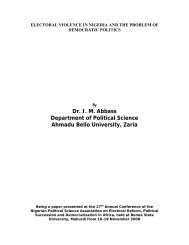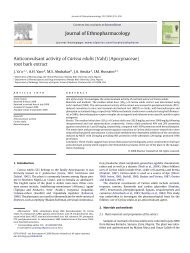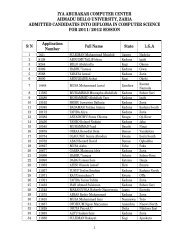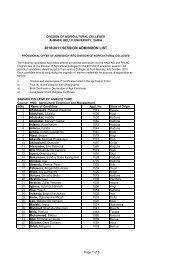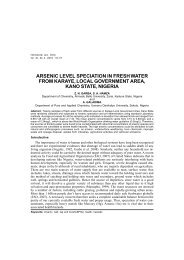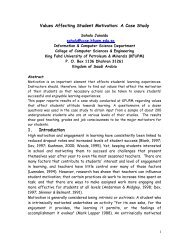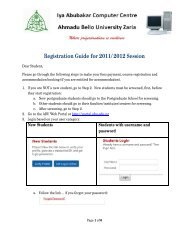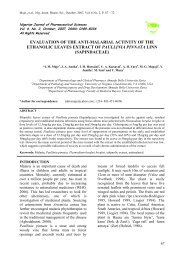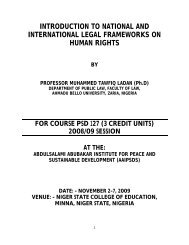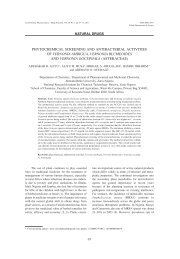Effects of N-Butanol Portion of Indigofera Pulchra - Ahmadu Bello ...
Effects of N-Butanol Portion of Indigofera Pulchra - Ahmadu Bello ...
Effects of N-Butanol Portion of Indigofera Pulchra - Ahmadu Bello ...
Create successful ePaper yourself
Turn your PDF publications into a flip-book with our unique Google optimized e-Paper software.
European Journal <strong>of</strong> Scientific Research<br />
ISSN 1450-216X Vol.22 No.4 (2008), pp.501-507<br />
© EuroJournals Publishing, Inc. 2008<br />
http://www.eurojournals.com/ejsr.htm<br />
<strong>Effects</strong> <strong>of</strong> N-<strong>Butanol</strong> <strong>Portion</strong> <strong>of</strong> Indig<strong>of</strong>era <strong>Pulchra</strong> Leaves<br />
Extract on Blood Glucose Levels <strong>of</strong> Alloxan-Induced<br />
Diabetic and Normoglycemic Wistar Rats<br />
Tanko. Y<br />
Department <strong>of</strong> Human physiology Faculty <strong>of</strong> Medicine<br />
<strong>Ahmadu</strong> <strong>Bello</strong> University Zaria, Nigeria<br />
E-mail: yusuftanko@yahoo.com<br />
Abdelaziz. M.M<br />
Department <strong>of</strong> Human physiology Faculty <strong>of</strong> Medicine<br />
<strong>Ahmadu</strong> <strong>Bello</strong> University Zaria, Nigeria<br />
Adelaiye. A.B<br />
Department <strong>of</strong> Human physiology Faculty <strong>of</strong> Medicine<br />
<strong>Ahmadu</strong> <strong>Bello</strong> University Zaria, Nigeria<br />
Fatihu. M.Y<br />
Department <strong>of</strong> Vet. Pathology and Microbiology, Faculty <strong>of</strong> Vet. Medicine<br />
<strong>Ahmadu</strong> <strong>Bello</strong> University,Zaria. Nigeria<br />
Musa. K.Y<br />
Department <strong>of</strong> Pharmacognosy and Drug Development, Faculty <strong>of</strong> pharmaceutical<br />
Sciences <strong>Ahmadu</strong> <strong>Bello</strong> University Zaria, Nigeria<br />
Abstract<br />
The n-butanol portion <strong>of</strong> Indig<strong>of</strong>era pulchra leaves extract (papilionaceae) was<br />
assessed for blood glucose levels <strong>of</strong> normoglycemic and alloxan induced diabetes in Wistar<br />
rats. Different doses <strong>of</strong> the extract was tested after 18 hours fasted. And there blood glucose<br />
levels was measured at 0,2,4,8 and 24 hours after treatment. The highest dose (1000 mg/kg)<br />
administered did not significantly decreased the blood glucose levels <strong>of</strong> alloxan induced<br />
diabetic and normoglycemic rat after 4 and 8 hours <strong>of</strong> treatment. The doses <strong>of</strong> 250 and 500<br />
mg/kg significantly decrease the blood glucose levels <strong>of</strong> alloxan induced diabetic and<br />
normoglycemic Wistar rats. The activity resides more at the lowest dose <strong>of</strong> the extract 250<br />
mg/kg. The hypoglycemic and antihyperglycemic potentials <strong>of</strong> the n-butanol portion <strong>of</strong> the<br />
extract was comparable to that <strong>of</strong> biphasic isophane insulin (6.i.u/kg). The phytochemical<br />
screening revealed the presences <strong>of</strong> tannins, saponins and flavonoids. The median lethal<br />
dose (LD 50 ) in rats was calculated to be 2,154 mg/kg bodyweight. In conclusion, the doses<br />
<strong>of</strong> the extract has shown both significant (p
<strong>Effects</strong> <strong>of</strong> N-<strong>Butanol</strong> <strong>Portion</strong> <strong>of</strong> Indig<strong>of</strong>era <strong>Pulchra</strong> Leaves Extract on<br />
Blood Glucose Levels <strong>of</strong> Alloxan-Induced Diabetic and Normoglycemic Wistar Rats 502<br />
Keywords: Indig<strong>of</strong>era pulchra, n-<strong>Butanol</strong>, Hypoglycemic activity, Normoglycemic,<br />
Alloxan, Diabetes mellitus.<br />
1. Introduction<br />
Diabetes mellitus is a chronic metabolic disorder <strong>of</strong> impaired carbohydrates, fat and protein<br />
metabolism. It is characterized by hyperglycaemia expressed as abnormal glucose value, which is due<br />
to insulin deficiency and/or insulin resistance which results in decrease utilization <strong>of</strong> carbohydrate and<br />
excessive glycogenolysis and gluconeogenesis from amino acid by fatty acids (Pontiroli et al., 1994). It<br />
has been defined by the World Health Organization (WHO) on the basis <strong>of</strong> laboratory findings as a<br />
fasting venous plasma glucose concentration greater than 7.3 mmol/L (140mg/dl) or greater than 11.1<br />
mmol/L (200mg/dl) two hours after carbohydrate meal or two hours after oral ingestion <strong>of</strong> the<br />
equivalent <strong>of</strong> 7.5g <strong>of</strong> glucose.<br />
This disease is on the increase all over the world, especially in Africa where it was formerly<br />
regarded as the disease <strong>of</strong> the affluent (Amos et al., 1997).<br />
Diabetes is one <strong>of</strong> the most common non-communicable diseases worldwide when compared<br />
with the general population, mortality and morbidity is increased in diabetes, due to the associated<br />
chronic complications – both specific microvascular retinopathy, nephropathy) and non-specific<br />
macrovascular artherosclerosis). Acute metabolic complications (e.g. diabetic ketoacidosis) continue to<br />
be a cause <strong>of</strong> mortality in developing countries (Ayesha et al., 2002).<br />
Using current and projected estimates, it has been suspected that the global prevalence <strong>of</strong> type I<br />
diabetes mellitus will increase from 3.5 million in 1995 to 5.5 million in 2010 (Amos et al., 2000). For<br />
Africa, the projected increase is from 85,000 (1995) to 219,000 (2010).<br />
Recent estimates indicate there were 171 million people in the world with diabetes in the year<br />
2000 and this is projected to increase to 366 million by 2030 (WHO, 2007). It is associated with<br />
reduced life expectancy, significant mortality and diminished quality <strong>of</strong> life. In 2005 an estimated 1.1<br />
million people died from diabetes. The American Diabetes Association (ADA) estimated the national<br />
costs <strong>of</strong> diabetes in the USA for 2002 to be US$132 billion, increasing to US$192 billion in 2020<br />
(WHO, 2007). If this is the case in a developed country, talk more <strong>of</strong> a developing country like Nigeria<br />
where 30% <strong>of</strong> people with diabetes live in low and middle income countries causing 5% <strong>of</strong> the deaths<br />
globally each year and likely to increase by more than 50% in the next 10 years without urgent action<br />
(WHO, 2006).<br />
Because <strong>of</strong> the tendency <strong>of</strong> many pr<strong>of</strong>essionals to cling to the belief that only pharmaceutical<br />
products are <strong>of</strong> value, therefore, possible source <strong>of</strong> new drugs to complement the action <strong>of</strong> oral<br />
hypoglycaemia agents. Renewed attention to alternative medicines and natural therapies has stimulated<br />
a new wave <strong>of</strong> research interest into traditional practice. The World Health Organization (WHO)<br />
Expert Committee on Diabetes listed as one <strong>of</strong> its recommendations; further investigations into<br />
traditional methods <strong>of</strong> treating diabetes (WHO, 1980).<br />
Indig<strong>of</strong>era pulchra(Willd) family: papilionaceae is an annual non climbing herbs or shrub that<br />
can grow up to 1m tall. It is widely distributed throughout west-Africa (Hepper,1976). In<br />
ethnomedicine, the leaves are used to treat infected wound (Hepper,1976;Burkhill, 1995) while the<br />
decoction <strong>of</strong> the aerial part is used as prophylactic against snake-bite (Sule et al.,2003) and as antiinflammatory<br />
(Abubakar et al.,2007). Previous pharmacological studies on the methanol extract <strong>of</strong> the<br />
aerial part <strong>of</strong> this plant showed that it exhibited venom detoxifying activities (Abubakar et al.,2006).<br />
The present study was designed to test the hypoglycemic effect <strong>of</strong> n-butanol portion <strong>of</strong><br />
Indig<strong>of</strong>era pulchra leaves extract <strong>of</strong> on alloxan – induced and normoglycemic Wistar rats diabetes.
503 Tanko. Y, Abdelaziz. M.M, Adelaiye. A.B, Fatihu. M.Y and Musa. K.Y<br />
2. Materials and Methods<br />
2.1. Plant material<br />
Indig<strong>of</strong>era pulchra sample was collected from Samaru-Zaria in the month <strong>of</strong> October 2007 and was<br />
authenticated by A.U.Gallah <strong>of</strong> the Biological Sciences Department, <strong>Ahmadu</strong> <strong>Bello</strong> University Zaria-<br />
Nigeria where a voucher specimen (No.6558) was deposited. The leaves were air-dried and made into<br />
powder using pestle and mortar.<br />
2.2. Extraction<br />
The air- dried powdered plant material was extracted with 70% methanol using soxhlets apparatus, the<br />
solvent was removed in-vacuo to yeild a residue (100gms) referred to as methanol extract. 100 grams<br />
<strong>of</strong> the methanol extract was suspended in water and filtered, the water soluble part was extracted with<br />
n-butanol (4x500ml) to give 6gms n-butanol portion.<br />
2.3. Chemicals used<br />
All chemicals and drugs were obtained commercially and were <strong>of</strong> analytical grade. Alloxan<br />
monohydrate (Sigma).The Biphasic Isophane insulin AS Mixtard 30 HM Pen fill (Novo Nordisk AIS<br />
2880 Bagsvaerd, Denmark. NAFDAC Reg.no 04-1601).<br />
2.4. Acute toxicity study<br />
The lethal doses (LD 50 ) <strong>of</strong> the plant extract was determined by method <strong>of</strong> Lorke (1983) using 12 rats.<br />
In the first phase rats were divided into 3 groups <strong>of</strong> 3 rats each and were treated with the extract at<br />
doses <strong>of</strong> 10, 100 and 1000mg/kg body weight intraperitoneally. They were observed for 24 hours for<br />
signs <strong>of</strong> toxicity. In the second phase 4 rats were divided into 4 groups <strong>of</strong> 1 rat each and were also<br />
treated with the extract at doses <strong>of</strong> 1600, 2900 and 5000 mg/kg bodyweight (i.p).The median lethal<br />
dose (LD 50 ) was calculated using the second phase.<br />
2.5. Phytochemical screening<br />
The preliminary phytochemical screening <strong>of</strong> n-butanol portion <strong>of</strong> Indig<strong>of</strong>era pulchra leaves extract was<br />
carried out in order to ascertain the presence or absent <strong>of</strong> its constituents by utilizing standard<br />
conventional protocols (Trease and Evans, 1983).<br />
2.6. Animals and Induction <strong>of</strong> Diabetes Mellitus<br />
Wistar strain albino rats <strong>of</strong> both sexes weighing (180-200 g) bred in the Department <strong>of</strong> Pharmacology<br />
and Clinical Pharmacy, faculty <strong>of</strong> Pharmaceutical Sciences A.B.U Zaria, were used for the study <strong>of</strong> the<br />
effect <strong>of</strong> the n-butanol portion <strong>of</strong> Indig<strong>of</strong>era pulchra leaves extract on the blood glucose levels <strong>of</strong> the<br />
animals. The animals were fed ad libitum with pellet diet (Vital feeds, Jos, Nigeria) and water. They<br />
were kept and maintained under laboratory conditions <strong>of</strong> temperature, humidity and light (25 ± 1ºC and<br />
12 h light/dark cycle) respectively. We followed the Guide for the care and Use <strong>of</strong> Laboratory<br />
Animals, 1985, issued by the US Department <strong>of</strong> Health and Human Services, Public Health Service,<br />
National Institute <strong>of</strong> Health, NIH Publication No.86-23. The rats assigned to the diabetic groups were<br />
injected with alloxan monohydrate dissolved in sterile cold normal saline at a dose <strong>of</strong> 150 mg/kg body<br />
weight intraperitoneally as reported by earlier by (Kameswara Rao et al.,1999). Since alloxan is<br />
capable <strong>of</strong> producing fatal hypoglycemia as a result <strong>of</strong> massive pancreatic release <strong>of</strong> insulin, the rats<br />
were treated with 20% glucose solution intraperitoneally after 6 hours (Stanley et al., 2001).The were<br />
kept for the next 24 hours on 5% glucose solution bottles in their cages to prevent hypoglycemia .After<br />
a period <strong>of</strong> three days the rats with a blood glucose levels greater than 170mg/dl were considered<br />
diabetic and used for this research work (Stanley et al.,2001).
<strong>Effects</strong> <strong>of</strong> N-<strong>Butanol</strong> <strong>Portion</strong> <strong>of</strong> Indig<strong>of</strong>era <strong>Pulchra</strong> Leaves Extract on<br />
Blood Glucose Levels <strong>of</strong> Alloxan-Induced Diabetic and Normoglycemic Wistar Rats 504<br />
2.7. Experimental Design<br />
The alloxan -induced diabetic Wistar rats were randomly assigned into five groups (1-5) <strong>of</strong> five rats<br />
(n=5) each as follows, namely<br />
A. Group 1- Received normal saline i.p<br />
B. Group2- Received Biphasic Isophane Insulin 6 i.u/kg i.p(Stanley et al.,2001)<br />
C. Group3-Received 250mg/kg body weight <strong>of</strong> the n butanol portion <strong>of</strong> the extract i.p<br />
D. Group4- Received 500mg/kg body weight <strong>of</strong> the n-butanol portion <strong>of</strong> the extract i.p<br />
E. E.Group5- Received 1000mg/kg body weight <strong>of</strong> the n-butanol portion <strong>of</strong> the extract i.p<br />
The normoglycemic Wistar rats were also randomly assigned into five groups (6-10) with<br />
five rats (n=5) in each group as follows:<br />
F. Group 6- Received normal saline i.p<br />
G. Group7- Received Biphasic Isophane Insulin 6 i.u/kg i.p(Stanley et al.,2001)<br />
H. Group8-Received 250mg/kg body weight <strong>of</strong> the n-butanol portion <strong>of</strong> the extract i.p<br />
I. Group9- Received 500mg/kg body weight <strong>of</strong> the n-butanol portion <strong>of</strong> the extract i.p<br />
J. Group10- Received 1000mg/kg body weight <strong>of</strong> the n-butanol portion <strong>of</strong> the extract i.p<br />
2.8. Determination <strong>of</strong> blood glucose levels<br />
All blood samples were collected by cutting the tail-tip <strong>of</strong> the rats. Blood samples for blood glucose<br />
determination were collected from the tail at intervals <strong>of</strong> 0, 2, 4, 8 and 24 hours. Determination <strong>of</strong> the<br />
blood glucose level was done by the glucose-oxidase principle (Beach and Turner 1958) using the<br />
ONE TOUCH Basic (Lifescan, Milpitas, CA) instrument and results were reported as mg/dl (Rheney<br />
and Kirk, 2000).<br />
2.9. Statistical analysis<br />
Blood glucose levels were expressed in mg/dl as mean ± SEM. The data were statistically analyzed<br />
using ANOVA with multiple comparisons versus control group by Dunnett’s method. Values <strong>of</strong><br />
p
505 Tanko. Y, Abdelaziz. M.M, Adelaiye. A.B, Fatihu. M.Y and Musa. K.Y<br />
3.1. Acute toxicity study (LD 50 )<br />
The sign <strong>of</strong> toxicity were first noticed after 8-10 hours <strong>of</strong> extract administration. There was decreased<br />
locomotor activity, decreased feed intake, and prostration after 14 hours <strong>of</strong> extract administration. The<br />
median lethal dose (LD 50 ) in rats was calculated to be 2,154 mg/kg body weight.<br />
3.2. Blood Glucose levels <strong>of</strong> Alloxan-induced Diabetic Wistar rats<br />
Table 1 showed the results <strong>of</strong> the effects <strong>of</strong> three doses (250mg/Kg, 500mg/Kg and 1000mg/Kg) <strong>of</strong> n-<br />
butanol portion <strong>of</strong> the leaves extract <strong>of</strong> Indig<strong>of</strong>era pulchra, Insulin and control groups in alloxaninduced<br />
diabetic Wistar rats. The dose <strong>of</strong> Insulin and the three doses <strong>of</strong> the extract did not show any<br />
significant change in the blood glucose levels when compared to untreated control after 2 and 4 hours<br />
<strong>of</strong> treatments. However, after 8 and 24 hours <strong>of</strong> treatments the dose <strong>of</strong> insulin and 250mg/Kg <strong>of</strong> the<br />
extract showed a significant (p
<strong>Effects</strong> <strong>of</strong> N-<strong>Butanol</strong> <strong>Portion</strong> <strong>of</strong> Indig<strong>of</strong>era <strong>Pulchra</strong> Leaves Extract on<br />
Blood Glucose Levels <strong>of</strong> Alloxan-Induced Diabetic and Normoglycemic Wistar Rats 506<br />
results in decreased Insulin levels and hyperglycemia leading to type 1 diabetes mellitus. However,<br />
animal models <strong>of</strong> diabetes differ significantly from each other and none can be taken, without<br />
reservation, to reproduce the essentials <strong>of</strong> human diabetes (Bell and Hyde, 1983).<br />
In the alloxan-induced diabetic groups, the effect <strong>of</strong> three doses (250mg/Kg, 500mg/Kg and<br />
1000mg/Kg) <strong>of</strong> n-butanol portion <strong>of</strong> Indig<strong>of</strong>era pulchra, Insulin and control groups were evaluated.<br />
The dose <strong>of</strong> Insulin and the three doses <strong>of</strong> the extract did not show any significant change in the blood<br />
glucose levels when compared to untreated control after 2 and 4 hours <strong>of</strong> treatments. However, after 8<br />
and 24 hours <strong>of</strong> treatments the dose <strong>of</strong> insulin and 250mg/Kg <strong>of</strong> the extract showed a significant<br />
(p
507 Tanko. Y, Abdelaziz. M.M, Adelaiye. A.B, Fatihu. M.Y and Musa. K.Y<br />
References<br />
[1] Abdel-Barry JA, Abdel-Hassan IA,Al-Hakiem,MHH (1997).Hypoglycemic and antihyperglycemic<br />
effects <strong>of</strong> Trigonella foenum-graecum leaf in normal and Alloxan induced<br />
diabetic rats.J Ethnopharmacol 58:149-155.<br />
[2] Abubakar M.S., Balogun E., Abdurrahman E.M., Nok A.J., Shok, M. Mohammed A. and Garba<br />
M. (2006).Ethnomedical treatment <strong>of</strong> poisonous snakebites: Plant extract neutralized Naja<br />
nigricollis venom. Pharmaceutical Biology, 44(5):343-348<br />
[3] Abubakar, M.S., Musa, A.M.,Ahmed, A. and Husaini,I.M.(2007). The perception and practice<br />
<strong>of</strong> traditional medicine in the treatment <strong>of</strong> cancers and inflammations by the Hausa and Fulani<br />
tribes <strong>of</strong> Northern Nigeria. Journal <strong>of</strong> Ethnopharmacology, 111(3):625629.<br />
[4] Amos, A.F., McCarthy, D.J., and Zimmet, D.Z. (1997). The king global burden <strong>of</strong> diabetes and<br />
its complications part 1: diagnosis and classification <strong>of</strong> diabetes mellitus provisional report <strong>of</strong><br />
WHO consultation. Diabet med. Vol. 15 pp. 539-553.<br />
[5] Amos, A.F., McCarthy, D.J., Zimmet, P. (1997). Diabetic Medicine 14:37-585. Ayesha, A.N.,<br />
Mohammed, A.K.O. and Fraser, J.P. (2003). Type <strong>of</strong> diabetes mellitus in Africa: epidemiology<br />
and pathogenesis; Africa Health, vol. 24, No. 2, pp.13.<br />
[6] Beach, E.F., and Turner, J.J. (1958). An enzymatic method for glucose determination uptake in<br />
body fluids. Clin Chem. 4:462-468.<br />
[7] Bell,RH ,Hye,RJ (1983).Animal models <strong>of</strong> diabetes mellitus:Physiology and Pathology.J.Surg<br />
Res 35:4333-460.Burkill,H.M.(1995).The Useful Plants <strong>of</strong> West Tropical Africa .Royal botanic<br />
garden Kew, 3:361-384<br />
[8] Brain, K. R and Turner, T. D.(1975) The Practical Evaluation <strong>of</strong> Phytopharmaceuticals,<br />
Wright Scientechnica, Bristol, pp. 57 – 58.<br />
[9] Duncan, R.C., Knapp, R.G., Miller, M.C. (1977). Test <strong>of</strong> hypothesis in population Means. In:<br />
Introductory Biostatistics for the health sciences. John Wiley and Sons Inc. NY pp.71-96.<br />
[10] Herper,F.N.(1976).The West African Herbaria <strong>of</strong> Isert and Thoning. Bentham-moxin trust in<br />
association with Carlsberg foundation, Kew, England.P 92<br />
[11] Kamewara Rao,B.,Giri.,Kesavulu, M.M.,Apparao, CH.(1997): Herbal medicine: In the<br />
management <strong>of</strong> diabetes mellitus. Manphar Vaidhya Patrika 1(1,5)33-35.<br />
[12] Lork D 1983. A New Approach to Practical Acute Toxicity Testing Archieves <strong>of</strong> Toxicology:<br />
275-287.<br />
[13] Mahesh, T. and Menon, P.V. (2004). Quercetin alleviates oxidative stress in streptozotocin<br />
induced diabetic rats. Phytotherapy Research, 18: 123-127.<br />
[14] Marles, J.R.and Farnsworth, N.R.1995. Antidiabetic plants and their active<br />
constituents.Phytomedicine 2 (2)123-89.<br />
[15] Pontiroli A.E., Ealdera, A., Pozza, G. (1994). Diabetes, metabolism Reveiws,vol 10,No 31.<br />
[16] Rheney, C.C., Kirk, K.K. (2000). Performance <strong>of</strong> three blood glucose meters. Ann<br />
Pharmacother. March, 34 (3) 317-21.<br />
[17] Sri Balasubashini, M., Rukkumani, R., Viswanathan, P. and Menon, P.V. (2004). Ferulic acid<br />
alleviates lipid peroxidation in diabetic rats. Phytotherapy Research, 18: 310-314.<br />
[18] Stanley,A mainzen P,Venugopal MP.(2001).Anti-oxidant action <strong>of</strong> Tinospora cordifolia root<br />
extract in alloxan diabetic rats.Phytother Res.15:213-218.<br />
[19] Sule,M.I., Pateh,U.U., Haruna,A.K., Garba,M., <strong>Ahmadu</strong>,A.A. and Adamu,A.K.(2003)Plants<br />
used in Hausa traditional medicine in Northern Nigeria.Journal <strong>of</strong> Tropical Bioscience, 3: 17-20<br />
[20] Trease, G.E. and Evans, M.C. (1983). Textbook <strong>of</strong> Pharmacognosy, 13 th ed. Bailliere, Tindall,<br />
London, pp. 683-684.<br />
[21] WHO Expert Committee (1980). Diabetes Mellitus. Second Report, Technical Report series 64:<br />
World Health Organization Geneva.<br />
[22] World Health Organization (2006). Definition diagnoses and classification <strong>of</strong> Diabetes Mellitus<br />
and intermediate hypoglycemia Report <strong>of</strong> the WHO/IDF Consultation. Geneva, Switzerland.


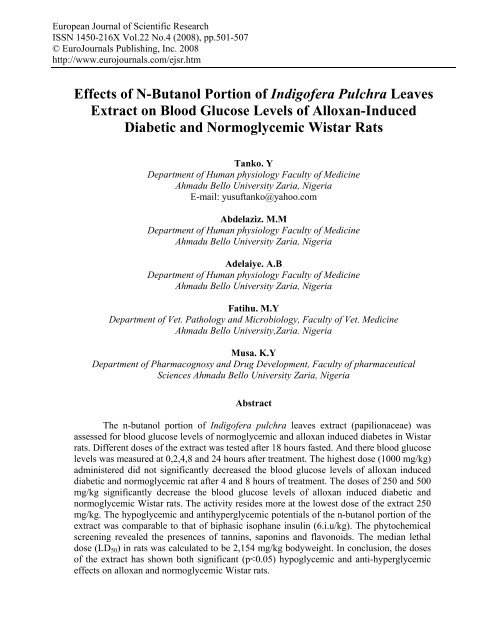
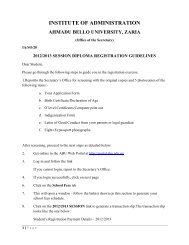
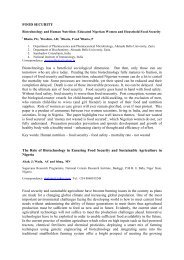
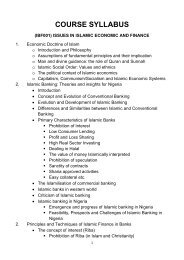
![Full Paper [PDF]](https://img.yumpu.com/49740055/1/184x260/full-paper-pdf.jpg?quality=85)
